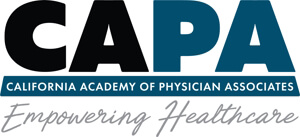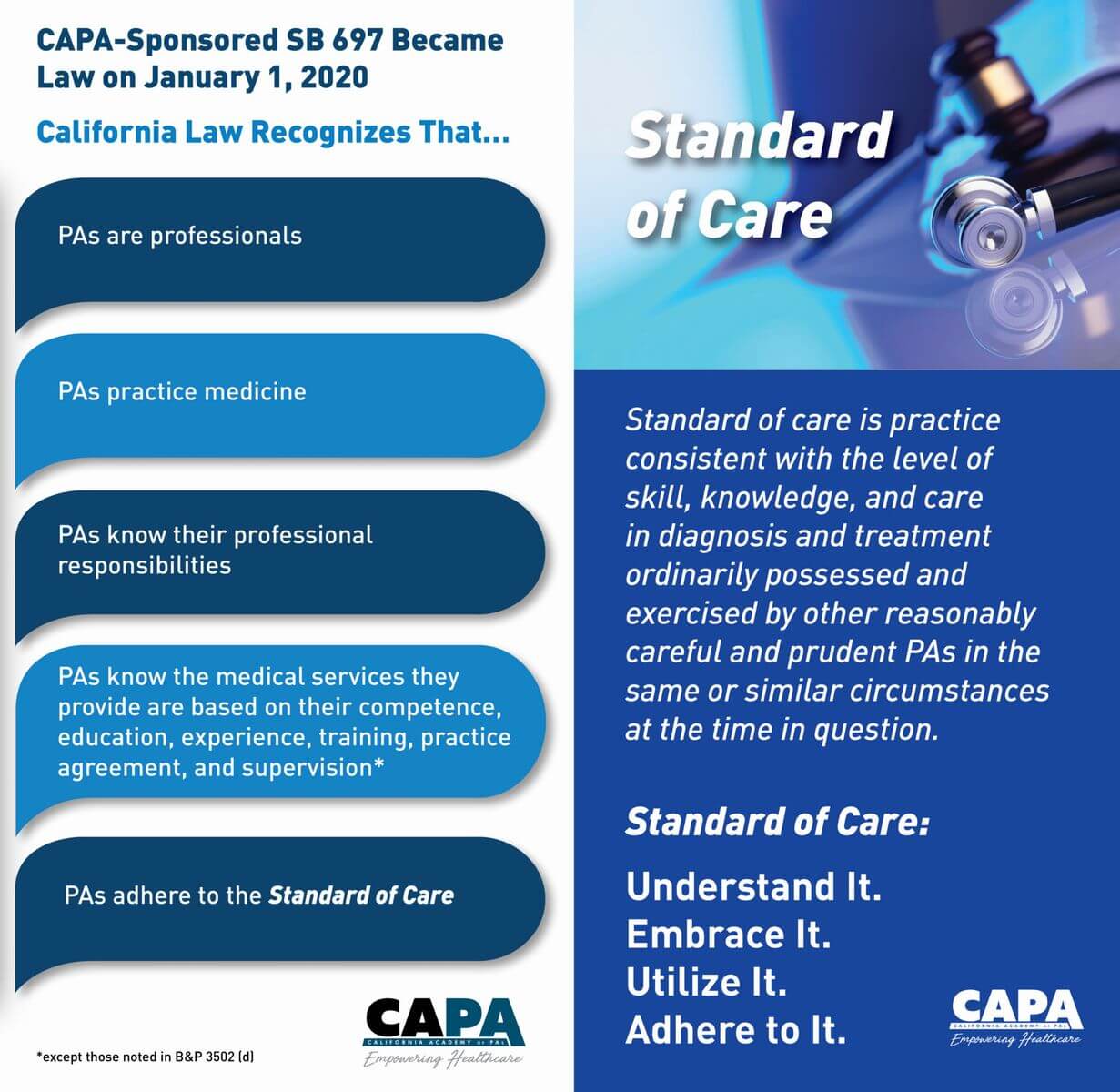Keys To SB 697
Overview Of SB 697
First Step – Understand the Terms: Practice Agreement and Standard of Care
As we begin to educate PAs about the provisions of SB 697, we want to start with Standard of Care. Beginning January 1, 2020, the provisions of SB 697 will cause an exciting paradigm shift in the PA profession. In many ways, SB 697 eliminates state-level micromanaging of PA practice in favor of a collaboratively developed practice-level model. One key aspect of this shift is how PA practice enforcement by the PA Board of California (PAB) will conform with how all other medical professionals are regulated in California. Today we want to shine a light on a legal term known as Standard of Care.
While the term Standard of Care may be new to some PAs, it has always been applied to PAs (and all medical professionals) when complaints are investigated. Prior to SB 697, there has been an additional unique burden on PAs which other healthcare professionals do not have. That burden was due to the fact that a Supervising Physician (SP) had to delegate, through a Delegation of Services Agreement (DSA), particular tasks. And, those tasks and procedures had to be consistent with the SP’s specialty or usual and customary practice. If something was not expressly delegated to the PA (e.g. a simple laceration repair) then there could be grounds for discipline, even if the repair was performed perfectly and the PA had the competence, education, experience, etc.
With the implementation of SB 697, the medical services provided by PAs are no longer delegated or specifically outlined in statute or regulations*. Appropriately, this puts increased importance and a stronger focus on Standard of Care. PAs are held to professional standards for their contributions to healthcare.
Practice Agreement
Keep in mind, the Practice Agreement is a written document, developed through collaboration among one or more physicians and surgeons at the practice and one or more PAs, that defines the medical services the PAs are authorized to perform in that particular practice. No longer is the section of regulations entitled: Medical Services Performable limiting and no longer are the medical services you provide “delegated.” You own your scope. It is no longer necessary to couple the services you are competent and capable to provide with one particular SP. Your Practice Agreement is literally an agreement “with the practice.” In an enforcement case, the PAB will need to determine that the PA was rendering only those services pursuant to the Practice Agreement. Additionally, the PA will need to be competent, educated, trained, experienced, supervised and adherent to the standard of care. Currently, practices are responsible for taking reasonable steps to ensure all those in the practice are competent to perform their functions. The PA, as a responsible healthcare professional, will only render those services that their education, training, and experience have prepared the PA to render, which they feel competent to provide, and are consistent with the standard of care.
Standard of Care
The level of skill, knowledge, and care in diagnosis and treatment ordinarily possessed and exercised by other reasonably careful and prudent PAs in the same or similar circumstances at the time in question. In an enforcement action or malpractice case, the review of the case is concerned primarily with whether there is a departure from the accepted standard of care. In other words, did the PA do that which a competent PA, even minimally but still competent PA, would do under similar circumstances? As you learn more about the provisions of SB 697, we encourage you to share the information with your practice administrators and the physicians within the practice. Help your practice better utilize your knowledge, expertise, and competencies – making you even more valuable to the practice and to patients.
Chart Reviews and Co-Signatures
In 2019, SB 697 (Caballero) was passed by the California Senate and Assembly and was signed by Governor Gavin Newsom on October 9, 2019. The bill went through Senate and Assembly committees and floor votes with zero “no” votes.
Supporters of this bill recognized the need to make the changes in our PA Practice Act to reflect the quality of healthcare delivery by PAs in our state and to reduce unnecessary administrative burdens imposed by outdated statutes. There will be a paradigm shift for PAs practicing in California with the new laws going into effect on January 1, 2020.
Among other changes, the law will no longer require medical chart reviews or co-signatures by a supervising physician (SP). Before SB 697 there were somewhat confusing requirements for chart review, dating, and co-signing of medical records by the SP – some within 30 days, others within 7 days. These laws and regulations led to unclear interpretations and layers of administrative challenges
to try to remain in compliance.
The PA Board (PAB) also may, as a condition of enforcement or reinstatement of a license, require the review or countersignature of medical records for a specified duration.
*Absent a few longstanding limitations identified in B&P 3502(d) (e.g. the practice of dentistry)
In 2019, SB 697 (Caballero) was passed by the California Senate and Assembly and was signed by Governor Gavin Newsom on October 9, 2019. The bill went through Senate and Assembly committees and floor votes with zero “no” votes. Supporters of this bill recognized the need to make the changes in our PA Practice Act to reflect the quality of healthcare delivery by PAs in our state and to reduce unnecessary administrative burdens imposed by outdated statutes. There will be a paradigm shift for PAs practicing in California with the new laws going into effect on January 1, 2020.
Among other changes, the law will no longer require medical chart reviews or co-signatures by a supervising physician (SP). Before SB 697 there were somewhat confusing requirements for chart review, dating, and co-signing of medical records by the SP – some within 30 days, others within 7 days. These laws and regulations led to unclear interpretations and layers of administrative challenges to try to remain in compliance.
The PA Board (PAB) also may, as a condition of enforcement or reinstatement of a license, require the review or countersignature of medical records for a specified duration.
As of January 1, 2020, PAs are no longer delegated be delegated the authority to perform particular medical services. Instead, an agreement with the practice defines medical services a PA may provide within that practice.
How will practices determine if a PA is authorized to (fill in this blank with a medical service)?
| Is the PA supervised? | Supervision means that a physician oversees the activities of, and accepts responsibility for, the medical services rendered by a PA. Supervision shall not be construed to require the physical presence of a physician. |
| Does the PA have a Practice Agreement? | The Practice Agreement must be developed through collaboration among one or more physicians, defining the medical services ** the PA is authorized to perform and grants approval for one or more physicians on staff to supervise one or more PAs. |
| Is there a physician electronically available at the time the PA examines the patient? | Physician supervision is required but does not mean physical presence. Electronic availability of a physician within the practice is necessary. |
| Is the PA competent to perform the services? | At the practice level, PA competence shall be established and maintained. PAs will undergo a periodic review of their competence within their practice. |
| Has the PA's education, training, and experience prepared the PA to render the services? | At the practice level, healthcare professionals will determine that the PAs education, training, and experience have prepared the PA to provide medical services consistent with the standard of care. |
The answers to these five questions will be your guide to many questions. In general, if you answer YES to all 5 questions, then it would appear that the PA may provide that service (unless otherwise restricted by the practice and/or other provisions of CA law that may impose restrictions or conditions).
*As of January 1, 2020, there is no requirement that a physician who supervises PA(s) in the practice share a particular area of medicine or specialty.
**Pay attention to provisions of CA law that may impose restrictions or conditions.
The content of this document is being provided for general informational purposes only and is not legal advice or a substitute for legal counsel. Given that the medical services performed by PAs can vary greatly from practice to practice, the reader should contact their attorney to obtain legal advice tailored to their specific circumstances.







